6 Tips for the Best Packaging Layout Design
By: phase1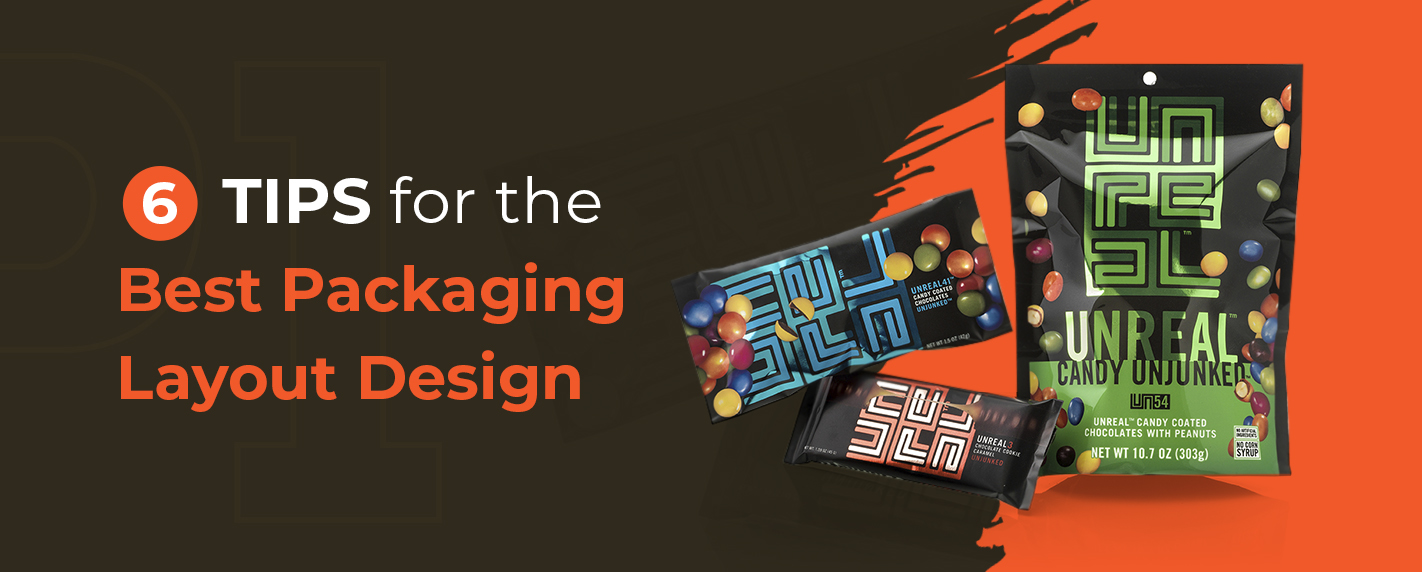
Every time you walk down the aisle of a grocery or retail store, you expose yourself to competition between brands and products. Each product’s packaging is vying to grab your attention. Some companies will rely on their established brand awareness to do the work. Other companies looking for a fresh start might go with creative packaging that attempts to set itself apart from the competition with its visual appeal.
Whatever strategy a company goes with, the strength or weakness of their products’ packaging design will impact their sales.
Why You Should Care About Packaging
Without a visually appealing product packaging design, you are setting your product up for failure. There are many different types of packaging, and a product’s success hinges on its packaging’s ability to convince customers they will be investing in something worth the money.
If you’re a new company, having well-designed packaging on your products will communicate a level of legitimacy and professionalism to potential investors and customers. For established companies, your packaging maintains your brand’s image and fuels brand loyalty. Ignoring your packaging is not an option no matter how established your company is, as it will impact your bottom line.
Design and Layout Tips for Packaging
If you’re going to design the perfect packaging for your new product, you’ll need a place to start. We’ve compiled the essential packaging design and layout tips you’ll need to begin creating eye-catching designs below.
1. Keep It Consistent
In all of your branding efforts, it’s crucial to establish an image that is instantly recognizable to consumers. Whether you build your brand image with your logo, colors, typography or whatever else, you can achieve brand recognition by keeping your brand’s image consistent. Your products’ packaging is one of the first areas where you can maintain brand consistency.
While you don’t need to plaster your logo everywhere on your packaging, you want to ensure your packaging’s design reflects your brand’s identity and values. Branding is more than just the colors, fonts and logo you use. Those qualities certainly play a part, but more importantly, branding is showing people your company’s personality, commitment to quality and desire to provide value to customers.
With substantial branding efforts behind your products and marketing strategy, you can increase your brand’s authority, consistently generating new customers and retaining them as well. Without a defined brand, you will confuse the market, hurting your ability to keep customer’s returning to your products and creating loyalty. If you want to drive customers to your products, impact your bottom line positively and give your products a solid ROI, you want to keep your brand’s packaging consistent.
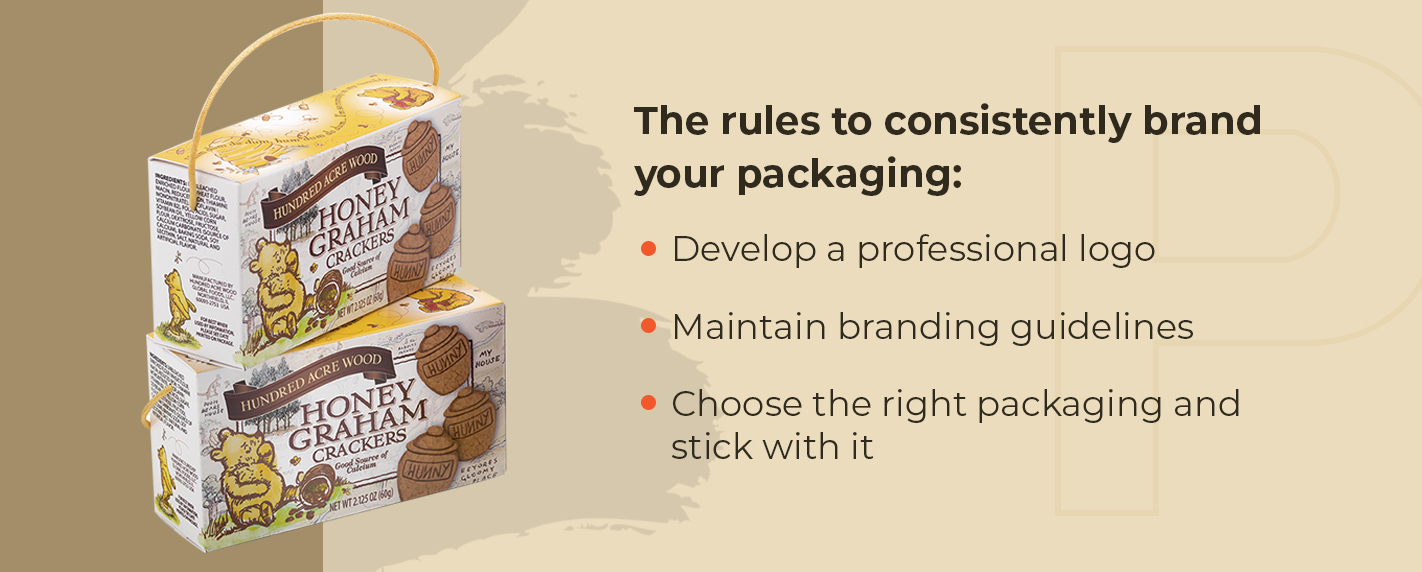
If you want to consistently brand your packaging, there are a few rules you need to keep in mind.
- Develop a professional logo: Your logo is going to be on every piece of marketing material your team puts out. From large advertising banners to small email signatures, you will be using your logo daily. Craft a logo you’ll be proud to put on your packaging.
- Maintain branding guidelines: Set branding guidelines that include the tone of voice, general color schemes, professional terminology and visual tone throughout your company. With these guidelines in place, you’ll be prepared to create packaging that reflects the brand.
- Choose the right packaging and stick with it: There are several ways you can package a product, and each one sends a different message about your brand. Will you be going with a serviceable square box or something a little more flashy? Or, would a sealed bag work better for the product? Whatever you choose, the packaging should stay consistent to increase brand recall.
2. Make It Easy to Understand
Since customers are only going to spend four seconds considering your product on the shelf, you need to send a message quickly. More importantly, you need to convey a message will make them want to buy your product or at least consider it in the future. To do this, you need your packing to answer two fundamental questions:
- What does this product do?
- What brand is selling it?
Of course, answering the first question is essential, because you want the consumer to know right away if the product matches their needs. If they don’t have any need for your product at the moment, but can see what your product is, no problem. You will have made a good impression on them by not wasting their time with poor packaging that makes them unable to tell what the product is. Also, you will increase your chances of them choosing your product the next time they need something like it.
However, if a customer does need the product you’re offering and your packaging doesn’t immediately tell them what it does, you will lose out on valuable customers. As a general rule, a simple design that shows off the uses for the product is going to be better-received than a complex design that loses the use of the product in the message.
In addition to communicating what your product does, you want your packaging to tell the audience who is selling it. For instance, if you’ve already established a strong brand identity through marketing materials, you want customers to know at a glance that the product you’re selling comes from you — a brand that they’ve come to trust. Additionally, if you’re still establishing your brand, your packaging will help your brand awareness and work toward increasing your future sales.
Many companies rely on their brand’s familiarity and authority in the minds of customers to sell products. They do this because it works, and your company should too. Start by designing your packaging with the brand clearly present.
3. Include Texture
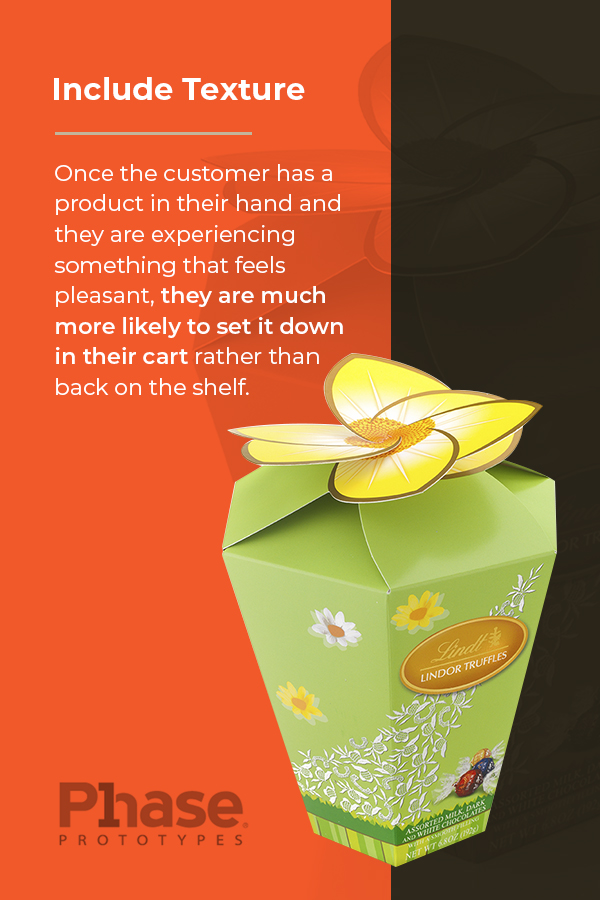
The visual appeal of the product will get customers to look at your product, but often, they will end up passing it by and going with something else. How do you prevent this? Use texture to add a tactile appeal to your product by making it inviting and pleasing to the touch. Once the customer has the product in their hand and they are experiencing something that feels pleasant, they are much more likely to set it down in their cart rather than back on the shelf.
You can add texture to your packaging in several ways that will be pleasant to the eye and the touch. Consider the following.
- Embossed packaging: One of the most popular ways that we add texture to the packaging of our clients is to emboss it. Embossing a package means part of the surface of your packaging is raised to give it some depth. This textural element will make your product look more high-end and make it pleasing to not only the touch but also the eye.
- Hot or cold stamping: With this form of packaging, you can add a special color or metallic effect to the package. While this will provide some color contrast, a metallic section of your packaging could give a literal change in temperature on parts of it, making it very enticing to the touch.
- Gloss laminate or matte laminate: Gloss laminate is a visually stunning choice of laminate that gives vibrancy to images. This durable form of packing catches the eye easily. It is smooth to the touch and easy to wipe free of fingerprints. In contrast, matte laminate provides a more elegant and professional look. It is especially popular due to the velvety texture that makes it almost irresistible to touch.
4. Think About How a Consumer Will Use It
For all of the visual appeal and beauty of your packaging, you need to make sure it’s functional for your customers as well. Take, for instance, food packaging, squeezable condiment bottles for products like ketchup, mustard and mayonnaise. Their squeezability works perfectly to spread them on hot dogs, sandwiches and hamburgers. This packaging puts the customer’s needs first and has become a staple of condiments.
Whether or not you sell condiments, the principle of the squeeze bottle applies. Put yourself in the consumer’s shoes to understand how they will be using the product and how you can make it even easier to use for them. Thoughtful packaging will include the following elements.
- Practicality of use: Like in the previously given example of squeezable condiment bottles that are designed to sit upside down, you want to think about how the packaging can provide practical use to your customers and complement the product itself. Rather than sticking to the standard designs for your products’ packaging, think about how you can innovate and solve any inconveniences associated with your products’ packaging. Making the consumer’s life more comfortable will win you their loyalty and differentiate yourself from the competition.
- Meet consumer expectations: As you create a product’s packaging, you want to understand the consumer’s expectations for the product. For example, let’s imagine you are a snack company. If you sell the snacks in bulk, customers will expect that they can reseal the package after they open it, since they will be using it over multiple days. By using resealable packaging, you will meet consumers’ expectations and win their trust.
- Easy handling: For any product, you want to make it as easy as possible to transport and handle. The packaging plays a huge role in the ease of handling, as it can come with handles or grooves designed to help carry or use the product. If the packaging makes the product hard to move or to use, you’ll likely send customers searching for other companies that have their convenience in mind.
5. Consider How It Will Look on a Shelf
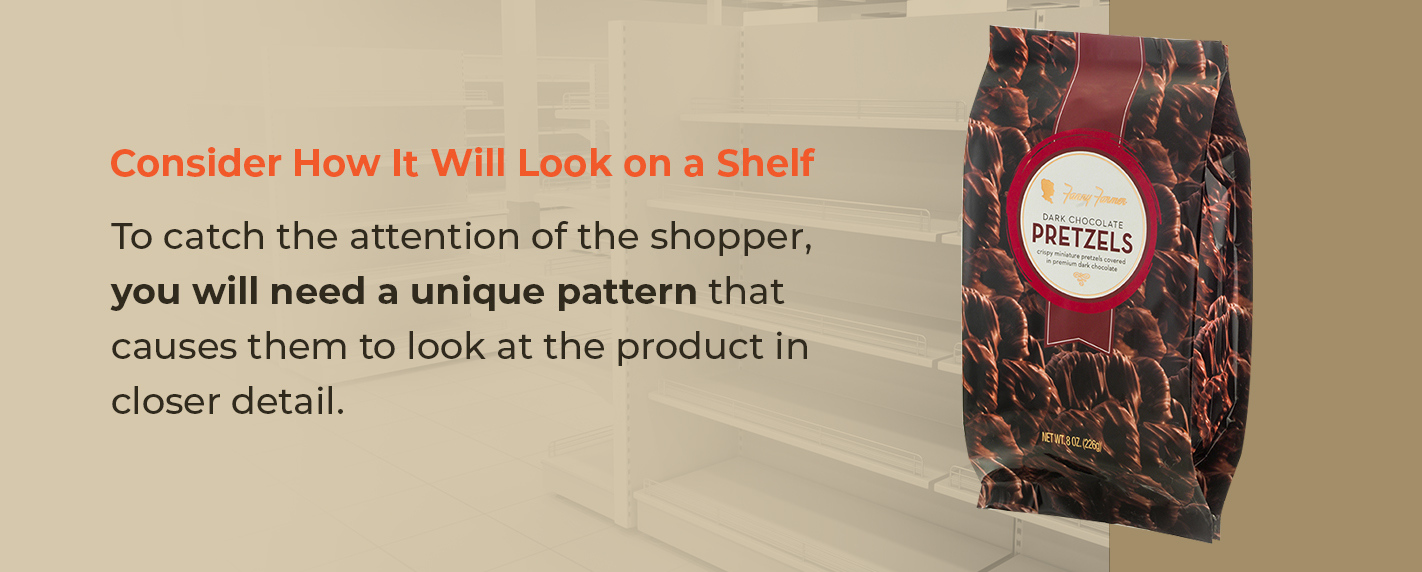
While your product sits on a shelf, it will almost always be in the company of similar products. Consumers will often not see it in great detail and will simultaneously be looking at a variety of rival products that meet their needs. Due to the consumer’s normal viewing distance of the shelves and the products’ arrangement in columns and rows, all the consumer will usually see is patterns made of products, not the products themselves.
To catch the attention of the shopper, you will need a unique pattern that causes them to look at the product in closer detail. Crafting a unique pattern plays into a key element of marketing called “shelf impact,” which refers to the appeal of a product while it sits on a shelf.
To ensure more shelf impact, you’ll want to test a variety of designs to find out which one pops to those passing by. To do this, you can set up a mock shelf with competing products surrounding the products you would like to sell in a store. Use several columns and rows for best results, and try out a variety of your packaging designs to see which one stands out to viewers the most.
Even the best-looking, most unique package design may blend in with the other packaging on the shelf, so you’ll always want to test any of your packages for their shelf impact.
6. Create a Prototype
If you’re looking to test your packaging’s shelf impact before you OK a package’s design, you’ll need to have a mockup of the packaging made. You won’t truly know how visually appealing a design will be on a package until you can see it. To craft a prototype, you have a couple of options.
- Digital mockup: If you’re looking for a way to see your design quickly, you can prepare a digital mockup that will give you an idea of how your packaging will look with the design applied to it. For this mockup, you’ll place the design onto a photorealistic image of a package. The programs that allow you to do this will typically generate a 3D result so you can better visualize how your product will look on the shelf.
- Print mockup: Would you rather have a physical version of your packaging to see before you make a final decision? A print mockup will let you see if your packaging is the correct size and give you a physical prototype to view. Additionally, it will show which parts of the package will stick out to customers and let you feel secure that you made the right choice. You can get your print mockup on cheap or high-quality material depending on your needs.
Either type of prototype, whether digital or print, can help you visualize your designs and make sure your packaging will represent your brand and the product in the best way possible. Digital prototypes are perfect if you’re trying to decide on different designs and need to compare them, while you can use print prototypes for more technical purposes.
Interested in a Prototype?
Whether you need a digital or print prototype, we know how to help. At Phase 1 Prototypes, we understand how important mockups can be in the design process and make it our mission to provide you with only the best printing services with the speediest turnaround times.
Do you want to learn more about how a mockup could benefit you and help you develop the best packaging design possible? A representative would be happy to speak with you and discuss how we can be of service to your business. If you’re looking for someone to print your latest prototypes, request a quote today.

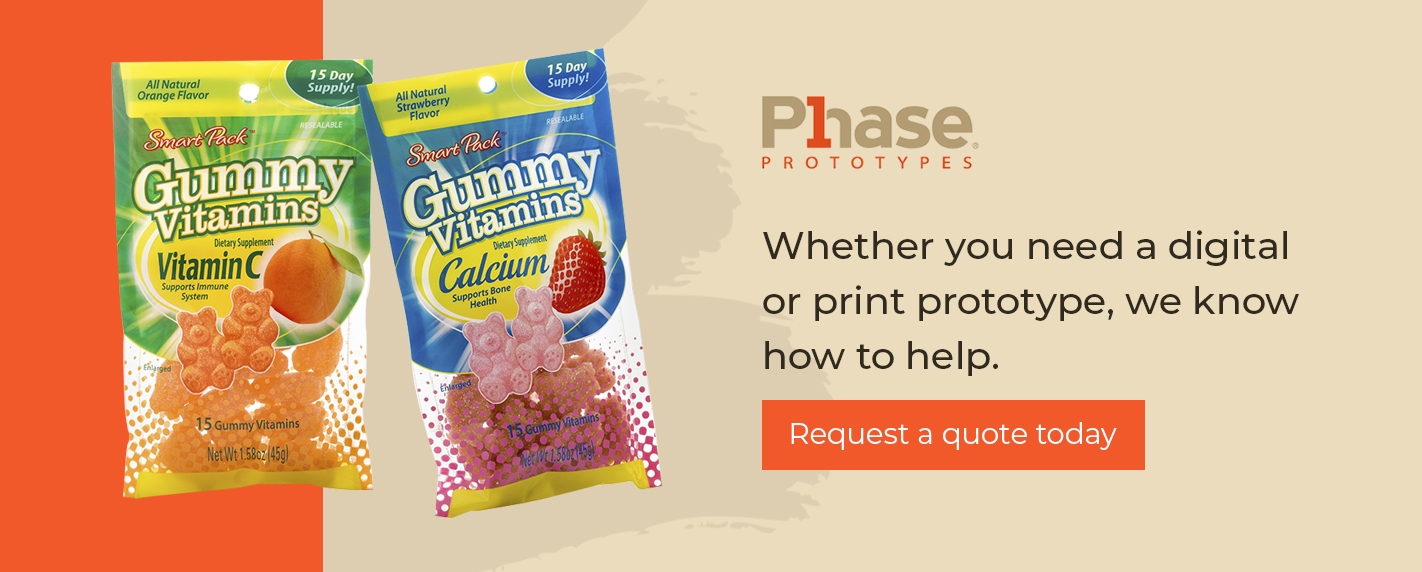
Leave a Reply